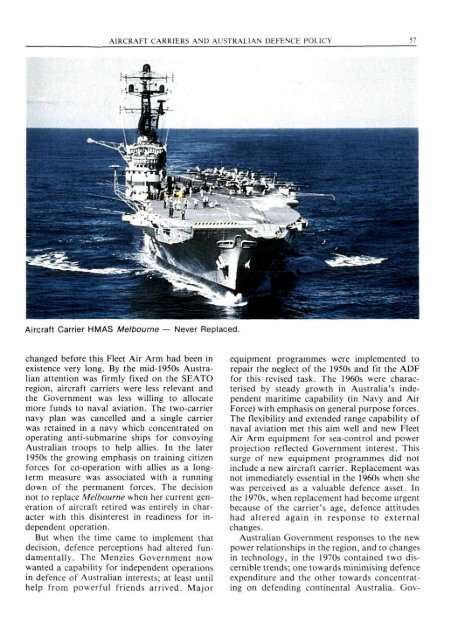ISSUE 61 : Nov/Dec - 1986 - Australian Defence Force Journal
ISSUE 61 : Nov/Dec - 1986 - Australian Defence Force Journal
ISSUE 61 : Nov/Dec - 1986 - Australian Defence Force Journal
You also want an ePaper? Increase the reach of your titles
YUMPU automatically turns print PDFs into web optimized ePapers that Google loves.
AIRCRAFT CARRIERS AND AUSTRALIAN DEFENCE POLICY 57<br />
Aircraft Carrier HMAS Melbourne — Never Replaced.<br />
changed before this Fleet Air Arm had been in<br />
existence very long. By the mid-1950s <strong>Australian</strong><br />
attention was firmly fixed on the SEATO<br />
region, aircraft carriers were less relevant and<br />
the Government was less willing to allocate<br />
more funds to naval aviation. The two-carrier<br />
navy plan was cancelled and a single carrier<br />
was retained in a navy which concentrated on<br />
operating anti-submarine ships for convoying<br />
<strong>Australian</strong> troops to help allies. In the later<br />
1950s the growing emphasis on training citizen<br />
forces for co-operation with allies as a longterm<br />
measure was associated with a running<br />
down of the permanent forces. The decision<br />
not to replace Melbourne when her current generation<br />
of aircraft retired was entirely in character<br />
with this disinterest in readiness for independent<br />
operation.<br />
But when the time came to implement that<br />
decision, defence perceptions had altered fundamentally.<br />
The Menzies Government now<br />
wanted a capability for independent operations<br />
in defence of <strong>Australian</strong> interests; at least until<br />
help from powerful friends arrived. Major<br />
equipment programmes were implemented to<br />
repair the neglect of the 1950s and fit the ADF<br />
for this revised task. The 1960s were characterised<br />
by steady growth in Australia's independent<br />
maritime capability (in Navy and Air<br />
<strong>Force</strong>) with emphasis on general purpose forces.<br />
The flexibility and extended range capability of<br />
naval aviation met this aim well and new Fleet<br />
Air Arm equipment for sea-control and power<br />
projection reflected Government interest. This<br />
surge of new equipment programmes did not<br />
include a new aircraft carrier. Replacement was<br />
not immediately essential in the 1960s when she<br />
was perceived as a valuable defence asset. In<br />
the 1970s, when replacement had become urgent<br />
because of the carrier's age, defence attitudes<br />
had altered again in response to external<br />
changes.<br />
<strong>Australian</strong> Government responses to the new<br />
power relationships in the region, and to changes<br />
in technology, in the 1970s contained two discernible<br />
trends; one towards minimising defence<br />
expenditure and the other towards concentrating<br />
on defending continental Australia. Gov-

















